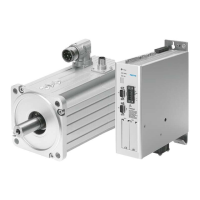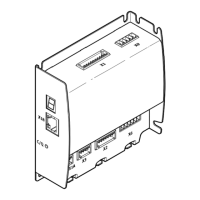6Functions
Festo – GDCP-CMMP-M0-FW-E N – 1304N H 21
Absolute positioning linear/rotative axis
Here, the positioning target is moved to regardless of the current position. With absolute positioning
the target position is a fixed (absolute) position relative to the zero point or reference point.
Absolute positioning, modulo axis
The target position of the positioning record is travelled to with modulo correction. Example: 490°
for modulo 360, the axis is positioned to 130°.
Relative positioning, linear/rotative axis
With relative positioning, the target position is obtained by adding a value to the current position.
Referencing is necessary to bring the drive into a defined position.
Concatenation of relative positioning can be used to continuously position in the same direction, such
as for a trimming unit or conveyor (incremental dimensions). The following options are available:
– Relative reference to the last target position
– Relative reference to the current position (actual position)
Relative positioning, modulo axis
The target position of the positioning record is not travelled to with modulo correction. Example: 490°
the axis travels positively around 490°.
Positioning with analogue setpoint
The target position is determined through the analogue setpoint specification at AIN0 [X1]. The follow-
ing options are available:
– Absolute reference to the projec t zero point
– Relative reference to the last target position
– Relative reference to the current position
– Continuous positioning corresponding to the analogue setpoint specification ( joystick function)
Speed
The maximum speed at whic h movement to the position is to take place.
Acceleration
Setpoint value of ac c eleration for the positioning record.
Deceleration
Setpoint value of the positioning record deceleration.
Smoothing
With travel profiles, a distinction is made between time-optimised and jerk-limited positioning. With
time-optimised positioning, motion occ urs with the maximum specified ac c eleration and braking. The
drive moves to the tar get in t he shortest possible time, the speed sequence is trapezoidal and t he
acceleration sequence square. With jerk-limited positioning, the acceleration is trape zoidal and the
speed curve is third-order. Since the acceleration constantly changes, the drive moves in a manner that
is especially gentle to the mechanics.

